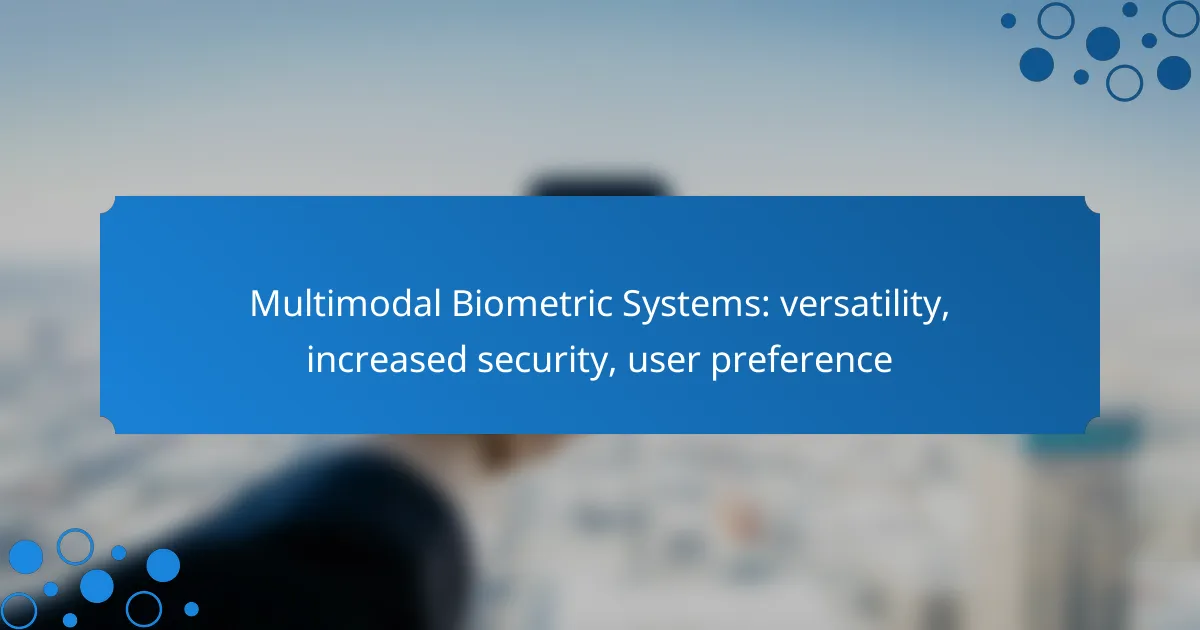Multimodal biometric systems represent a significant advancement in security technology by integrating various biometric traits, such as fingerprints, facial recognition, and iris scans. This combination not only enhances accuracy and reliability but also addresses the limitations of single-modality systems, ultimately catering to user preferences and improving overall user experience.

How do multimodal biometric systems enhance security in Canada?
Multimodal biometric systems enhance security in Canada by combining multiple biometric traits, such as fingerprints, facial recognition, and iris scans, to create a more robust identification process. This integration significantly reduces the likelihood of unauthorized access and improves overall accuracy in verifying identities.
Integration of multiple biometric modalities
Multimodal biometric systems leverage various biometric traits to improve security and user verification. For example, a system might require both a fingerprint and facial recognition to grant access, making it harder for unauthorized users to bypass security measures. This integration not only enhances security but also accommodates different user preferences and situations.
By combining modalities, organizations can tailor their security measures to specific environments, such as airports or financial institutions, where higher security levels are crucial. The flexibility in choosing which biometrics to use can lead to better user acceptance and satisfaction.
Reduction of false acceptance rates
False acceptance rates (FAR) refer to the likelihood that an unauthorized user is incorrectly identified as an authorized one. Multimodal biometric systems significantly lower these rates by requiring multiple forms of verification, which makes it difficult for impostors to succeed. For instance, a system that uses both voice recognition and facial recognition is less likely to mistakenly grant access compared to one that uses only a single biometric trait.
In practical terms, organizations can expect FAR reductions in the range of tens of percent when implementing multimodal systems. This improvement not only enhances security but also builds trust among users who rely on these systems for sensitive transactions.
Real-time threat detection
Multimodal biometric systems can facilitate real-time threat detection by continuously monitoring and analyzing multiple biometric inputs. For example, if a facial recognition system detects a match with a known criminal database while simultaneously processing voice patterns, it can trigger immediate alerts for security personnel. This proactive approach allows for quicker responses to potential threats.
Organizations can implement these systems in high-risk areas, such as border control or secure facilities, where timely identification of threats is critical. By integrating real-time analytics, these systems can enhance situational awareness and improve overall safety for users and the public.

What are the key benefits of multimodal biometric systems?
Multimodal biometric systems enhance security and user experience by combining multiple biometric traits, such as fingerprints, facial recognition, and iris scans. This approach mitigates the weaknesses of single-modality systems, offering increased accuracy and reliability while catering to user preferences.
Increased accuracy and reliability
Multimodal biometric systems significantly improve accuracy by cross-verifying multiple biometric traits. This reduces the likelihood of false positives and negatives, which can occur with single-modality systems. For example, if a fingerprint scan fails due to dirt or injury, a facial recognition check can still authenticate the user.
Reliability is further enhanced as these systems can adapt to varying environmental conditions. For instance, a facial recognition system may struggle in low light, but a voice recognition component can still function effectively, ensuring consistent performance.
User convenience and preference
User convenience is a major advantage of multimodal biometric systems, as they allow individuals to choose their preferred authentication method. This flexibility can lead to higher user satisfaction and adoption rates. For example, a user may opt for facial recognition in a well-lit environment but switch to fingerprint scanning in a different setting.
Moreover, these systems can streamline the authentication process, reducing wait times. By allowing simultaneous input of multiple biometric traits, users can experience quicker access without compromising security.
Scalability for various applications
Multimodal biometric systems are highly scalable, making them suitable for a wide range of applications, from personal devices to large-scale security systems. Businesses can implement these systems in various environments, such as airports, banks, and corporate offices, adapting to specific security needs.
Furthermore, as technology evolves, these systems can incorporate new biometric modalities, such as behavioral biometrics, without requiring a complete overhaul. This adaptability ensures that organizations can maintain robust security measures as threats evolve.

Which industries benefit most from multimodal biometric systems?
Multimodal biometric systems enhance security and user experience across various industries by combining multiple biometric traits, such as fingerprints, facial recognition, and iris scans. This versatility leads to improved accuracy and reduced chances of false positives, making these systems particularly valuable in sectors that prioritize security and user identification.
Financial services and banking
In the financial sector, multimodal biometric systems are crucial for secure transactions and identity verification. Banks often utilize a combination of fingerprints and facial recognition to authenticate users during online banking or ATM withdrawals, significantly reducing fraud risks.
Implementing these systems can streamline customer experiences, allowing for quicker access to services while maintaining high security. Institutions should ensure compliance with regulations like GDPR in Europe or similar standards in other regions to protect user data.
Healthcare and patient identification
Healthcare providers benefit from multimodal biometric systems by ensuring accurate patient identification and safeguarding sensitive medical records. By using a combination of biometric identifiers, such as fingerprints and facial recognition, hospitals can minimize the risk of patient misidentification, which can lead to critical errors in treatment.
These systems can also enhance patient experience by facilitating faster check-ins and reducing wait times. However, healthcare facilities must prioritize data privacy and adhere to regulations like HIPAA in the United States to protect patient information.
Government and law enforcement
Government agencies and law enforcement utilize multimodal biometric systems for secure identification and access control. These systems can integrate various biometric data, such as fingerprints, facial images, and voice recognition, to enhance security measures at borders and in public spaces.
For example, biometric passports and national ID systems often employ multiple modalities to verify identities accurately. Agencies should consider the balance between security and privacy, ensuring that data collection complies with legal standards and respects citizens’ rights.

What factors should be considered when choosing a multimodal biometric system?
When selecting a multimodal biometric system, it’s crucial to consider system compatibility, cost-effectiveness, and user experience. These factors will significantly influence the system’s performance, adoption, and overall success in enhancing security.
System compatibility and integration
System compatibility is essential for ensuring that the multimodal biometric system can work seamlessly with existing infrastructure. Check if the system can integrate with current hardware and software, such as access control systems or databases, to avoid costly upgrades or replacements.
Additionally, consider the interoperability of different biometric modalities, like fingerprint and facial recognition. A well-integrated system should allow for easy switching between modalities, enhancing flexibility and user convenience.
Cost-effectiveness and ROI
Evaluating the cost-effectiveness of a multimodal biometric system involves analyzing initial investment, maintenance costs, and potential return on investment (ROI). Look for systems that offer a balance between affordability and advanced features, as this can lead to long-term savings.
Calculate the ROI by considering factors such as reduced fraud, improved security, and increased efficiency. A system that minimizes unauthorized access can save organizations significant amounts in potential losses over time.
User experience and interface design
User experience is a critical factor in the adoption of multimodal biometric systems. A user-friendly interface can facilitate quick enrollment and authentication processes, making it easier for users to interact with the system.
Consider the design of the interface and the clarity of instructions provided. Systems that offer intuitive navigation and feedback can enhance user satisfaction and reduce frustration, leading to higher acceptance rates among users.

How do multimodal biometric systems compare to traditional systems?
Multimodal biometric systems enhance security and user experience by integrating multiple biometric traits, such as fingerprints and facial recognition, unlike traditional systems that rely on a single trait. This combination improves accuracy and reduces the likelihood of false matches, making them more reliable for authentication.
Enhanced security features
Multimodal biometric systems offer enhanced security by requiring multiple forms of identification, which makes unauthorized access significantly more difficult. For example, a system might require both a fingerprint and facial recognition, ensuring that even if one trait is compromised, the system remains secure.
These systems also utilize advanced algorithms to analyze biometric data, which can detect spoofing attempts, such as using fake fingerprints or photos. As a result, they provide a higher level of protection against identity theft and fraud.
Broader user acceptance
Users tend to prefer multimodal biometric systems because they offer flexibility and convenience. For instance, if a user has difficulty with one biometric method, such as a fingerprint due to injury, they can still authenticate using another method like facial recognition.
Additionally, the integration of multiple biometric modalities can cater to diverse user preferences and cultural contexts, increasing overall acceptance in various regions. This adaptability can lead to higher user satisfaction and engagement.
Improved data protection measures
Multimodal biometric systems enhance data protection by storing biometric information in a more secure manner. Instead of keeping raw biometric data, many systems use templates that are less vulnerable to breaches, ensuring that sensitive information is not easily compromised.
Moreover, these systems often comply with stringent data protection regulations, such as the General Data Protection Regulation (GDPR) in Europe, which mandates strict guidelines for handling personal data. This compliance helps organizations build trust with users regarding their privacy and data security.

What are the emerging trends in multimodal biometric technology?
Emerging trends in multimodal biometric technology focus on enhancing security, improving user experience, and integrating various biometric modalities. This approach combines multiple biometric traits, such as fingerprints, facial recognition, and iris scans, to provide a more robust authentication method.
Versatility of Multimodal Biometric Systems
Multimodal biometric systems offer significant versatility by allowing the use of different biometric traits for authentication. This adaptability means that if one biometric trait is compromised or fails, others can still provide access. For instance, a system might use both facial recognition and fingerprint scanning, ensuring that users can authenticate even if one method is temporarily unavailable.
Moreover, the integration of various modalities can cater to different user preferences and environments. For example, in high-security areas, a combination of iris recognition and voice authentication may be preferred, while in everyday applications, a simple fingerprint scan might suffice.
Increased Security
Increased security is a primary advantage of multimodal biometric systems. By requiring multiple forms of identification, these systems significantly reduce the likelihood of unauthorized access. For instance, if a fingerprint is spoofed, the system can still rely on facial recognition to verify the user’s identity.
Additionally, the use of advanced algorithms and machine learning can enhance the accuracy of biometric recognition, making it harder for malicious actors to bypass security measures. Organizations can implement these systems in various sectors, including finance and healthcare, where data protection is critical.
User Preference
User preference plays a crucial role in the adoption of multimodal biometric systems. Many users appreciate the flexibility of choosing their preferred authentication method, which can lead to higher satisfaction and compliance. For instance, some individuals may feel more comfortable using facial recognition, while others may prefer fingerprint scanning.
To accommodate diverse preferences, systems can be designed to allow users to select their preferred modalities during the setup process. This customization not only enhances user experience but also encourages broader acceptance of biometric technologies across different demographics.
